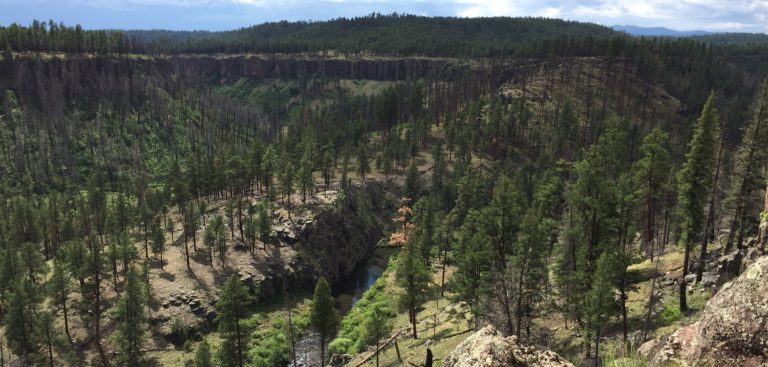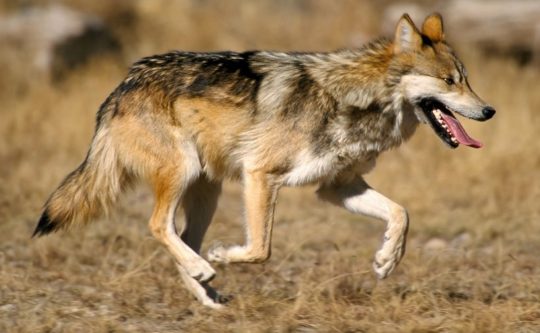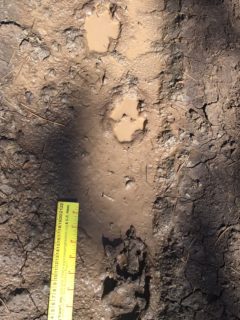
Walking the Paseo del Lobo
NORTHWEST/SOUTHWEST
It was her eyes that haunted Aldo Leopold. He watched the green fire fade from the dying mother wolf’s eyes in 1949. Later in his life, he referred to that moment as a pivotal experience for him:
“We reached the old wolf in time to watch a fierce green fire dying in her eyes. I realized then, and have known ever since, that there was something new to me in those eyes—something known only to her and to the mountain. I was young then, and full of trigger-itch; I thought that because fewer wolves meant more deer, that no wolves would mean hunters’ paradise. But after seeing the green fire die, I sensed that neither the wolf nor the mountain agreed with such a view.”
— Aldo Leopold, A Sand County Almanac, 1949
The wolf Leopold killed was a Mexican gray, Canis lupus baileyi, the most genetically distinct and most ancient subspecies of gray wolf in North America. They are the smallest of the continent’s wolves, and the rarest wolf in the United States. After nearly a century of persecution, the United States government’s predator eradication campaign pushed the Mexican gray wolf as close to extinction as a species can get: only four males and one pregnant female remained in the wilds of northern Mexico.
In 1976, the Mexican gray wolf was listed under the Endangered Species Act, and with no surviving wolves in the United States, the remaining five wolves were trapped in Mexico in the late 1970s. These few wolves were the foundation of a captive breeding program managed by the U.S Fish and Wildlife Service to revive and recover the species in an attempt to right the wrongs of previous times.

Since then, agencies, conservation organizations, and concerned citizens in the U.S. and Mexico have been working tirelessly to bring the Mexican gray wolf back from the brink of extinction. In 1997, a plan was approved calling for the reintroduction of Mexican gray wolves in Arizona and New Mexico. In March 1998, 11 Mexican gray wolves in three family groups were released from their captive breeding facilities into the wilds of the Apache National Forest of southeastern Arizona: two additional wolves were released later that year. All those involved in the recovery program celebrated in 1998 when, for the first time in decades, a Mexican gray wolf pup was born in the wild.
Wilburforce Foundation is committed to working with our partners to defend and use environmental policies that safeguard the Mexican gray wolf and the habitat their families need to thrive. The best available science tells us that there is substantial suitable habitat for this keystone species, and room for the population to expand to self-sustainable levels. Because of real and potential conflicts with this expanding population and existing uses of public lands, we also provide significant, long-term support for coexistence efforts between livestock ranchers, tribes, and recovering wolf packs that need to feed their pups.
To see this area for ourselves, strategize with our grantees, and learn about the Mexican gray wolf recovery efforts, this July we participated in the Grand Canyon Wolf Recovery Project’s Big Lake Howliday event. During that event, we visited the Apache-Sitgreaves National Forest and stood on the rim of Black Canyon, overlooking the site of that fateful day when Leopold killed the alpha female. The warm wind whipped our hair, bringing with it the rich scent of old growth ponderosa pine. Framed by basalt cliffs, the deep river canyon’s riparian corridor is active with many species including deer and elk, the preferred prey of the Mexican gray wolf.
The story of Leopold killing the wolf was told by one of our guides and it quieted our group. We asked questions, trying to understand and process something that happened decades prior but still impacts the landscape today.

As we left the rim and walked through the forest, an Arizona rattlesnake was spotted about 20 feet in front of our group. As we paused to let it pass, it gave us a few warning rattles and continued its journey. We watched our steps more closely and soon spotted tracks in the mud. Monsoon rains had drenched the forest the night before, creating puddles and thick mud along our path. The tracks were that of a canine. One of our guides broke out a ruler: the track measured 3×3 ½ inches. Further on, more tracks were spotted. The excitement grew in our group. The seasoned wildlife experts assessed the size of the paw prints and the stride: it was purposeful and tight. It was the stride of an animal walking with intention. A domestic dog tends to wander from side to side, but a wild canine walks more straight, not wasting a step.
It was a hopeful sign that nature, given a chance, can recover from our past mistakes. In the yearly Mexican gray wolf count performed by the US Fish and Wildlife Service, there were 113 Mexican gray wolves confirmed at the end of 2016, the largest number since the reintroduction effort began. However, the Mexican gray wolf faces many challenges ahead. In order to survive and thrive, the species needs an infusion of genetic diversity and an increase in population numbers.
The Mexican Wolf Recovery Plan is being updated for the first time since the original plan was created in the 1980s. As part of this process, the US Fish and Wildlife Service accepted public comment on its Draft Recovery Plan this summer and are reviewing those comments now.

Several of our grantees are working towards the recovery of this important species: to stay up to date on news and activities related to Mexican gray wolf recovery visit Grand Canyon Wolf Recovery Project’s website and the Mexican gray wolf Facebook page.
Story by Yolanda Morris, NWSW Program Associate and Courtney Price, Office Manager at Wilburforce Foundation.



